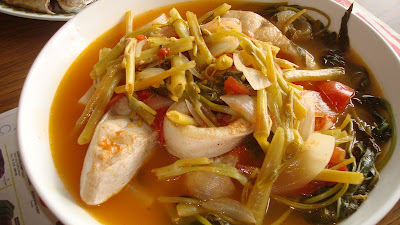One dish that my family loves to eat on a weekly basis is the Sinigang (Tamarind stew with either pork, beef, chicken or fish). The more sour the soup base the better. It's the pucker me come hither look that you want to achieve when you serve this dish, it says your stew is the genuine article. Maasim (very sour).
When I was in the Philippines, I always makes sure I buy the sampaloc (tamarind) fruit, the almost ripe variety, I then cook it on a separate pan, strain it till I get the juice. Then incorporate it in the soup.
That time consuming practice is of course now a thing of the past (thank heavens!), one can just buy the Pang-asim mix (tamarind powder) in any Asian store, then you can have your own filipino style Tamarind stew.
The fish I used in this recipe is the Basa. It's a type of catfish that is native to Vietnam. The taste is akin to bangus (milkfish) sans the tinik (bones). I added a dash of ginger powder so that it has a thai taste to it.
1 k Basa fillet
1 large tomato quartered
1 medium size onion sliced thinly
1/2tsp. ginger powder or 1tbsp. sliced fresh ginger
1 bunch kangkong (Water Spinach) stems and leaves separated
1 large size labanos ( white radish) cut into bite size pieces
3pcs. Gabi (taro root) cut into bite size pieces
fish sauce to taste or salt
1 Knorr Sabaw ng sinigang ( Knorr Tamarind powder)
1 1/2 cup water
In a non-stick pan cook onions with a little vegetable oil till translucent. Add tomato, taro and labanos. Add water ( you can add more water if you wish). Simmer on medium heat till tomatoes are pulpy and the taro and labanos are slightly soft when prick with a fork. Add fish and stems of kangkong, ginger and the tamarind powder. Cover and simmer for ten minutes. Add kangkong leaves, cook for five more minutes. Season to taste with fish sauce. Serve with rice and bagoong (shrimp paste)
(closer view of the Basa fillet)
Additional info: How to grow Kangkong in your home.


No comments:
Post a Comment